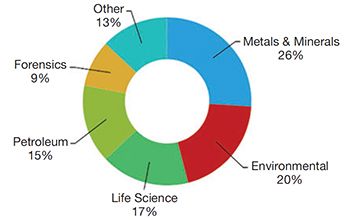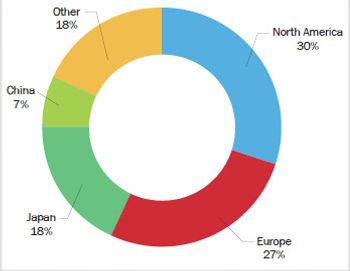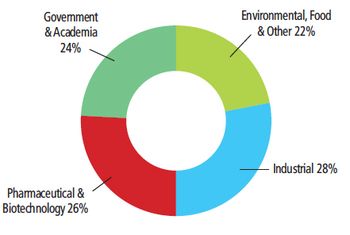
- Spectroscopy-03-01-2010
- Volume 0
- Issue 0
Market Profile: Process NMR
Somewhat unique among molecular spectroscopy techniques, the application of nuclear magnetic resonance (NMR) for industrial process analysis is driven primarily by the petroleum industry.
Somewhat unique among molecular spectroscopy techniques, the application of nuclear magnetic resonance (NMR) for industrial process analysis is driven primarily by the petroleum industry. Although the market for process NMR was heavily affected by the recent recession, it is a very valuable niche technique that will see demand rebound.
Process NMR demand by industry in 2009.
Although it falls into the category of molecular spectroscopy, NMR spectroscopy differs from other techniques in the category because it is not an optical technique. Instead, it uses a combination of magnetic and radio frequency (RF) radiation for analysis. This eliminates issues associated with optical techniques, while maintaining the advantages of being nondestructive, and providing continuous analysis, both of which are key to online instrumentation.
Process NMR is used most heavily by far in the petroleum refining industry, which is an area in which it was first applied in the mid-1990s. Process NMR, which can be applied at many locations within a refining process, can provide real-time data used for both feed-forward and feedback control. As sulfur content restrictions have tightened, refiners have become increasingly conservative, but by using process NMR, they are able to produce more product while controlling sulfur concentration. This can translate into additional profits of many thousands of dollars per day in an average-sized refinery. Other industries in which process NMR is used include in polymers for the monitoring of fluorinated materials and online process control, the monitoring of phosphorous in the mining and chemicals industry, and in the power generation industry.
All of the industries in which process NMR is used contracted considerably during the recession, resulting in global demand of around $5 million in 2009. However, demand should rebound fairly quickly, being led by the construction, expansion and improvement of refineries in rapidly growing markets such as China.
Contact: Stuart Press, Strategic Directions International, Inc., Los Angeles, CA (310) 641-4982,
Articles in this issue
almost 16 years ago
2010 Salary Surveyalmost 16 years ago
Defending the Food Chainalmost 16 years ago
A Random Walk Through the Web of Mass Spectrometryalmost 16 years ago
Electron Transitions in Optical Emission and X-Ray Fluorescence Spectrometryalmost 16 years ago
Spectroscopy Bounces Backalmost 16 years ago
Productsalmost 16 years ago
Vol 25 No 3 Spectroscopy March 2010 Regular Issue PDFNewsletter
Get essential updates on the latest spectroscopy technologies, regulatory standards, and best practices—subscribe today to Spectroscopy.





